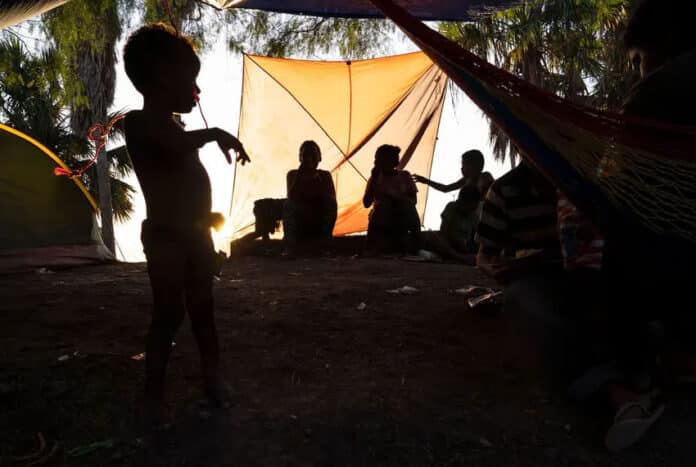
On the same afternoon he’s sworn in as the nation’s 46th president, Joe Biden will take executive actions that will undo several of former President Donald Trump’s immigration policies, his transition team announced Wednesday.
The list of orders includes reissuing protections established under the 2012 Deferred Acton for Childhood Arrivals program, halting further construction of a border barrier and rolling back interior immigration enforcement priorities put in place by the previous administration.
The actions come the same day Biden will reportedly send to Congress a comprehensive immigration bill that, if passed, could provide a legal path to citizenship for millions of undocumented immigrants, including more than 1.7 million in Texas.
“These actions are bold, begin the work of following through on President-elect Biden’s promises to the American people, and, importantly, fall within the constitutional role for the president,” the transition team said of the executive orders, which also include actions addressing the COVID-19 pandemic, eviction moratoriums, student loan debt and the environment.
The day-one order on DACA will instruct the homeland security secretary and attorney general to preserve the program, which as of June included about 645,000 beneficiaries, including about 106,400 in Texas, according to federal government statistics. Trump announced an end to DACA in 2017, but the program has endured after series of court challenges, including a 2020 decision by the U.S. Supreme Court that ruled the administration did not act properly in its order to end the policy.
But the Biden administration will also face a lawsuit from Texas Attorney General Ken Paxton, who filed a separate challenge that questions the legality of the program.
A separate Biden executive action seeks to roll back Trump’s interior enforcement initiatives and allow federal immigration agencies to “to set civil immigration enforcement policies.” In 2017, Trump quickly ended the Obama-era Priority Enforcement Program, which instructed federal, state and local agencies to focus their limited resources on the biggest threats to public safety, such as convicted or wanted felons and repeat offenders. The Biden transition team generally described Wednesday’s order as a way to return to “policies that best protect the American people and are in line with our values and priorities.”
On construction of a border barrier, Biden will end an emergency declaration that allowed Trump to divert billions of dollars in military construction and payroll funds for construction of the barrier. Last week in the Rio Grande Valley, Trump made his final visit as president to the border to celebrate about 450 miles of new barrier along the nearly 2,000-mile southern border. But according to U.S. Customs and Border Protection, several projects are under construction or in pre-construction phases, and the fate of current or pending contracts is unclear.
Biden’s order will pause construction as his administration reviews the funding and contracting methods used.
“Bipartisan majorities in Congress refused in 2019 to fund President Trump’s plans for a massive wall along our southern border, even after he shut down the government over this issue,” the transition website states.
Immigrant rights groups have called on Biden to issue the executive orders to grant immediate protections for some groups while Congress debates the larger, more comprehensive immigration bill, which would provide a pathway to citizenship for most of the undocumented immigrants in the country if they were in the United States by the beginning of this year.
There are an estimated 1.7 million undocumented immigrants living in Texas, including about 1.2 million from Mexico, according to the Washington-based Migration Policy Institute. The Biden proposal calls for granting five-year temporary status for qualified applicants, who would then be able to apply for a green card, or permanent residency status, if they passed background checks and paid taxes, according to the transition team’s statement.
It’s still unclear how many would be eligible to apply for relief under the Biden plan, which could face an uphill climb in the evenly divided U.S. Senate, where at least 10 Republicans would have to support the bill.
The proposed legislation also would provide DACA recipients, some agricultural workers and recipients of Temporary Protected Status a faster path to citizenship by letting them apply for green cards immediately. After three years, green card holders would be allowed to apply for citizenship if they pass additional background checks, learn English and learn about U.S. civics, according to the transition team.
The TPS program was established in 1990 under President George H.W. Bush and allows citizens of countries experiencing armed conflict, natural disasters or other emergencies to seek temporary refuge in the U.S. or extend their current stays. Texas has about 49,000 TPS recipients, most of them from Central America, according to Dan Wallace, deputy managing director of New American Economy, a bipartisan research group that focuses on the economic benefits of immigration.
Wallace said the TPS holders in Texas have about $1 billion in spending power, and 1 in 5 work in the construction industry, which has helped sustain the state’s economy.
“Just having the certainty that folks will be able to stay is so hopeful, not only for those individuals and their families but also for the employers and cities they live in,” he said.
Ali Noorani, executive director of the National Immigration Forum, an immigration advocacy group, said he’s optimistic Biden will be able to convince Congress to support the larger immigration proposal even though it lacks traditional border enforcement elements like more agents and barriers. The proposal instead calls for an increase in technology and infrastructure to better screen crossers and goods.
“I think that there is a certain amount of border exhaustion for the Republicans,” he said. “[Trump’s wall] was a great organizing tool, but not necessarily a very smart security tool. And the apprehension numbers [of undocumented border crossers] went up as Trump was building his wall.”



